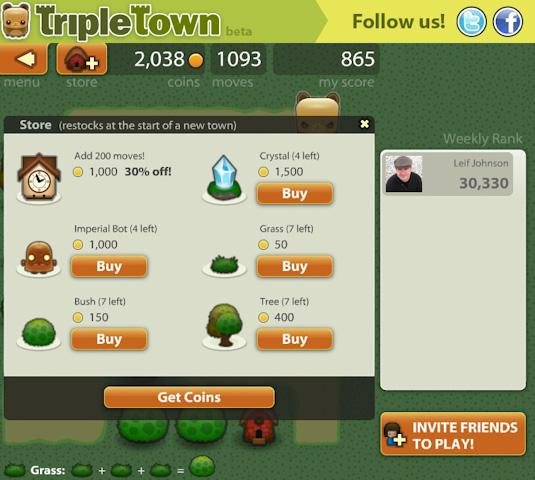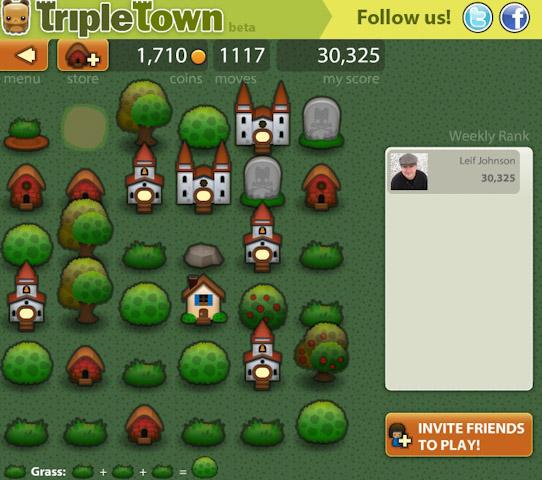- Wondering how to get Monopoly GO! free rolls? Well, you’ve come to the right place. In this guide, we provide you with a bunch of tips and tricks to get some free rolls for the hit new mobile game. We’ll …
Best Roblox Horror Games to Play Right Now – Updated Weekly
By Adele Wilson
Our Best Roblox Horror Games guide features the scariest and most creative experiences to play right now on the platform!The BEST Roblox Games of The Week – Games You Need To Play!
By Sho Roberts
Our feature shares our pick for the Best Roblox Games of the week! With our feature, we guarantee you'll find something new to play!Type Soul Clan Rarity Guide – All Legendary And Common Clans Listed!
By Nathan Ball
Wondering what your odds of rolling a particular Clan are? Wonder no more, with my handy Type Soul Clan Rarity guide.
Triple Town Review
I had to force myself to quit playing Triple Town in order to write this review, which might give you some idea of just how addicting it is. It’s almost scary. One minute I was logging in with the intention of taking a few screenshots and verifying a few notes, and the next I was grumbling that an hour had gone by and I hadn’t written a word. Triple Town was already incredible when it made its first appearance on the Kindle almost exactly a year ago, but this new Facebook release manages to improve on what even then seemed like an almost perfect puzzle strategy game. Combining challenge, fun, and gameplay that can last for hours or minutes, Triple Town is everything a casual game should be.

Triple Town makes the jump from Kindle to Facebook and gets better in the process
I had to force myself to quit playing Triple Town in order to write this review, which might give you some idea of just how addicting it is. It’s almost scary. One minute I was logging in with the intention of taking a few screenshots and verifying a few notes, and the next I was grumbling that an hour had gone by and I hadn’t written a word. Triple Town was already incredible when it made its first appearance on the Kindle almost exactly a year ago, but this new Facebook release manages to improve on what even then seemed like an almost perfect puzzle strategy game. Combining challenge, fun, and gameplay that can last for hours or minutes, Triple Town is everything a casual game should be.
Triple Town starts off with a random map that’s six spaces wide and six spaces deep, throughout which are scattered random objects such as trees, shrubs, and the occasional grumpy bear. Your basic mission is to build a town in this wilderness by combining three or more game pieces. These are randomly fed to you one by one, and you can build points and more impressive structures by combining the proper pieces. For instance, three grasses make a shrub, three shrubs make a tree, three trees make a cottage, and three cottages make a house. Every now and then you’ll get a crystal that acts as a wild card, and you can use this to finish off a triad that was previously hindering your gameplay. If you get a great piece that you can’t use at the moment, you can place it in a storehouse until you can.

But then you have those pesky bears to worry about. These guys change places with every move, which means they could block off a spot where you were planning to place a random item or make a match. You can stop them by walling them off and leaving them without moves, but then they just leave a stationary tombstone that’s almost as frustrating of an obstacle. Your only hope is to maneuver your pieces so you can combine three or more tombstones in order to make a church, but even then you’ll have to contend with sneaky ninja bears that leap across the screen and smash your handiwork. These are particularly nasty, and you can only get rid of them with an Imperial Bot that erases a bothersome piece on the board.
Much like chess, Triple Town thus requires thinking ahead at least a step or two in order to keep your board from filling up with bears, tombstones, or matchless pieces. It’s challenging enough that it leaves you feeling as though you exercised your brain, but it’s never so hard that it abandons fun for mental masochism. It even looks better than its Kindle forebear. The original Triple Town was a rather retro affair filled with wizards, flowers, and an ugly grid; the Facebook version provides a more coherent backdrop of woods, bears, and an overall sense of place that isn’t marred by the Kindle’s inferior graphical performance. Even the transitions that get you from patches of grass to full-blown castles seem to make more sense here.

If there’s a drawback to Triple Town, it’s that its only social feature is a weekly leaderboard that lets you match your scores against your friends. That in itself isn’t really a game-killer (after all, PopCap’s insanely popular Blitz games operate under much the same principle), but it would be nice to be able to send your friends a helpful item or two. As it is, the only way to get extra pieces is to purchase them at the store with the winnings you’ve earned for each match or reasonably priced stacks of coins. Veterans of the Kindle game might also balk at the inclusion of a moves bar that halts your gameplay once it runs out, but it refreshes quickly enough that it won’t pose a problem unless you spend hours playing the game. And even if you are, tossing SpryFox 75 cents for 200 more moves seems like a more than adequate way of saying thanks for such a sublimely addicting experience.

The good

The bad
More articles...
Monopoly GO! Free Rolls – Links For Free Dice
By Glen Fox
Wondering how to get Monopoly GO! free rolls? Well, you’ve come to the right place. In this guide, we provide you with a bunch of tips and tricks to get some free rolls for the hit new mobile game. We’ll …Best Roblox Horror Games to Play Right Now – Updated Weekly
By Adele Wilson
Our Best Roblox Horror Games guide features the scariest and most creative experiences to play right now on the platform!The BEST Roblox Games of The Week – Games You Need To Play!
By Sho Roberts
Our feature shares our pick for the Best Roblox Games of the week! With our feature, we guarantee you'll find something new to play!Type Soul Clan Rarity Guide – All Legendary And Common Clans Listed!
By Nathan Ball
Wondering what your odds of rolling a particular Clan are? Wonder no more, with my handy Type Soul Clan Rarity guide.







